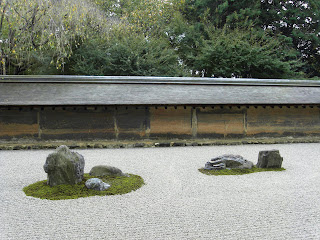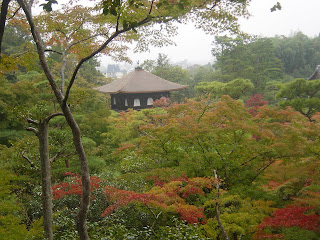 This is a one-day pass for the subway and bus ride (which costs 1200 yen). Another pass (500 yen), which is only for the bus ride, is also available.
This is a one-day pass for the subway and bus ride (which costs 1200 yen). Another pass (500 yen), which is only for the bus ride, is also available.  This is a time-indicator for the upcoming bus. As introduced in our previous blog entry (i.e., Modern or Primitive?), Kyoto has a very unique bus-ride system.
This is a time-indicator for the upcoming bus. As introduced in our previous blog entry (i.e., Modern or Primitive?), Kyoto has a very unique bus-ride system. 
 The above two pictures depict the famous Kinkakuji (English: Golden Pavilion). The reflection of the Pavilion in the pond is magnificent.
The above two pictures depict the famous Kinkakuji (English: Golden Pavilion). The reflection of the Pavilion in the pond is magnificent. This bell is located near the entrance of Kinkakuji. You can see a tint of autumnal colored leaves behind the bell. You can actually toll the bell.
This bell is located near the entrance of Kinkakuji. You can see a tint of autumnal colored leaves behind the bell. You can actually toll the bell.
 The above two pictures show how we can enjoy tea called Matcha (English: powered tea used for tea ceremony) in the garden of Kinkakuji.
The above two pictures show how we can enjoy tea called Matcha (English: powered tea used for tea ceremony) in the garden of Kinkakuji. Vendors promote free samples of wagashi (English: Japanese sweets) to passengers-by (i.e., students wearing their school uniform) in the garden of Kinkakuji.
Vendors promote free samples of wagashi (English: Japanese sweets) to passengers-by (i.e., students wearing their school uniform) in the garden of Kinkakuji.
 The above two pictures depict the famous rock garden in Ryouanji. The garden is said to represent the universe.
The above two pictures depict the famous rock garden in Ryouanji. The garden is said to represent the universe.  This picture depicts a miniature rock garden made for blind people so that they can sense how the rocks are located in the garden.
This picture depicts a miniature rock garden made for blind people so that they can sense how the rocks are located in the garden.
 These pictures show where we should wash our hands for purification before visiting a temple or shrine. This water basin lies in the garden leading to Ryouanji.
These pictures show where we should wash our hands for purification before visiting a temple or shrine. This water basin lies in the garden leading to Ryouanji.  This picture depicts a pond in the garden leading to the rock garden in Ryouanji. This place is very quiet as you can imagine.
This picture depicts a pond in the garden leading to the rock garden in Ryouanji. This place is very quiet as you can imagine. 
 These above two pictures show the path called Tetsugaku no Michi (English: Philosophical Path) leading to Ginkakuji (English: Silver Pavilion).
These above two pictures show the path called Tetsugaku no Michi (English: Philosophical Path) leading to Ginkakuji (English: Silver Pavilion).

 The above three pictures depict Ginkakuji (English: Silver Pavilion, although it is not covered with silver as Kinkakuji, or Golden Pavilion, with gold). This Pavilion was built later than Kinkakuji after the power of Shogunate declined, for which reason this Pavilion is not covered with silver.
The above three pictures depict Ginkakuji (English: Silver Pavilion, although it is not covered with silver as Kinkakuji, or Golden Pavilion, with gold). This Pavilion was built later than Kinkakuji after the power of Shogunate declined, for which reason this Pavilion is not covered with silver.
 The above two pictures show the garden of Ginakkuji.
The above two pictures show the garden of Ginakkuji.
This picture depicts Kiyomizu (temple). A Japanese famous saying "Kiyomizu no butai kara tobioriru" literally means jumping from the stage of this temple (i.e., the extended balcony in the picture). This saying is referred to mean "making a big decision" because, as you can see, its stage is so high that you have to overcome the fear and anxiety to make a big decision.

This picture shows how high the stage of Kiyomizu is.
 The above picture is a path (called Ninenzaka) consisting of stone stairs, which leads to Kiyomizu. Its sides are lined with gift shops, restaurants, and ice cream shops.
The above picture is a path (called Ninenzaka) consisting of stone stairs, which leads to Kiyomizu. Its sides are lined with gift shops, restaurants, and ice cream shops. This shop is one of the shops lining the Ninenzaka. This is the place where you can transform to a geisha girl by waring white make-up, Kimono, and special raised wooden footwear.
This shop is one of the shops lining the Ninenzaka. This is the place where you can transform to a geisha girl by waring white make-up, Kimono, and special raised wooden footwear.
 The above two pictures slightly depict how Gion looks like. The exploration in the evening or night time could give you a better sense of Gion.
The above two pictures slightly depict how Gion looks like. The exploration in the evening or night time could give you a better sense of Gion. This is the picture of Nanzenji, which is located to the north of Kiyomizu. This temple has a famous wooden gate, on the top of which you can have a magnificent view of Kyoto. The next picture shows that you have to climb steep stairs to reach the top of the gate.
This is the picture of Nanzenji, which is located to the north of Kiyomizu. This temple has a famous wooden gate, on the top of which you can have a magnificent view of Kyoto. The next picture shows that you have to climb steep stairs to reach the top of the gate.  This is the steep stairs leading to the magnificent view.
This is the steep stairs leading to the magnificent view.  The above picture shows a stone monument in the garden of Nanzenji.
The above picture shows a stone monument in the garden of Nanzenji. The above picture depicts the old water gate near Nanzenji. This place is a very famous spot where scenes in soup drams, e.g., murder scenes, are shot.
The above picture depicts the old water gate near Nanzenji. This place is a very famous spot where scenes in soup drams, e.g., murder scenes, are shot. 
 The above two pictures are gardens in the Eikando Zenrinji (temple), which is in the vicinity of Nanzenji. Eikando Zenrinji is famous for its fall foliage. This temple is not so well-known as Kiyomizu, but worth visiting. It is quiet and has interesting characteristics, as you can see from the following pictures.
The above two pictures are gardens in the Eikando Zenrinji (temple), which is in the vicinity of Nanzenji. Eikando Zenrinji is famous for its fall foliage. This temple is not so well-known as Kiyomizu, but worth visiting. It is quiet and has interesting characteristics, as you can see from the following pictures. This picture shows an earthen jar in the garden of Eikando Zenrinji. When water drops into the jar, it makes a sound. Since this place is quiet, you can enjoy its delicate sound.
This picture shows an earthen jar in the garden of Eikando Zenrinji. When water drops into the jar, it makes a sound. Since this place is quiet, you can enjoy its delicate sound.  In Eikando Zenrinji, you have to climb these steep stairs to enjoy its garden.
In Eikando Zenrinji, you have to climb these steep stairs to enjoy its garden.  The above picture shows the entrance of another minor but worth-visiting temple called Shoreiin. This temple is in the western part of Kyoto, or more specially is located between Kiyomozu and Nanzenji. This year, they have a special exhibit: a national treasure of scroll depicting Buddha. Check it out at http://www.shorenin.com/gokaicho/index.html
The above picture shows the entrance of another minor but worth-visiting temple called Shoreiin. This temple is in the western part of Kyoto, or more specially is located between Kiyomozu and Nanzenji. This year, they have a special exhibit: a national treasure of scroll depicting Buddha. Check it out at http://www.shorenin.com/gokaicho/index.htmlThe following pictures depict some other exhibits at Shoreiin.

 The above two pictures show a court carriage, where emperors, nobles, Shogunates comfortably sit. You can see sliding doors behind the carriage.
The above two pictures show a court carriage, where emperors, nobles, Shogunates comfortably sit. You can see sliding doors behind the carriage. 
This is a wall decoration inside the Shoreiin temple. Yellow part of the decoration is gold. These kinds of expensive decorations are made for emperors and nobles.
 This is another kind of decoration. This depicts a typical feature of the tea-ceremony room.
This is another kind of decoration. This depicts a typical feature of the tea-ceremony room. 
The above picture depicts a scroll displayed in Shoreiin. It says: We should believe in the existence of Buddha in our heart. Instead of yielding to earthly temptations, such as greed, hatred, and anger, we should always bear in mind the gratitude and considerations for others. Chant the Buddhist scriptures.











No comments :
Post a Comment